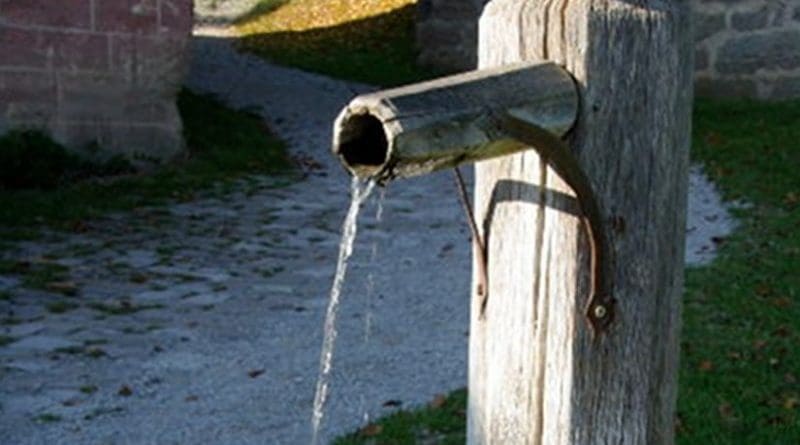Pakistan: The Most Water Stressed Country In South Asia By 2040 – OpEd
By Hina Mahar*
Pure water is the world’s first and foremost medicine because all the systems in our body function excellently in a water-rich environment. It would be best if one were well hydrated for one’s cells to run correctly. Nothing is essential to maintain life on this planet than pure drinking water in particular and clean water in general. Access to pure water is recognized as fundamental human right by United Nations General Assembly ( UNGA) and Human Rights Council as a part of binding international law in 2010 reflecting the fundamental nature of everyone’s daily life. Lack of access to the clean and affordable water has devastating effects on health, dignity and prosperity of billions of people around the world and has significant consequences for the realizing other human rights. However, from Cape Town to Flint Michigan and from rural sub Saharan Africa to Asia’s teeming megacities, everyone’s facing water crisis. People are distressed to get pure water they need for drinking, cooking, washing, bathing, growing food and more. The UN recently, restated that three billion people are suffering water shortages worldwide and that billions are facing hunger. However, in progressively popularized communities, such entreaties fall on deaf ears.
Pakistan’s biggest head ache, debatably, is water scarcity. Pakistan has reached an alarming water shortage phase. Many specialists say that Pakistan will reach a dire water scarcity level within a couple of years and will be the most water stressed country in South Asia within a decade or two. “Almost thirty million people have no access to clean water” (Huma Yusuf, 11.30.2020, Dawn). One might be unaware of this issue because it is yet to articulate a compelling narrative about the water crisis. According to a report by DW, Pakistan has the world’s fourth highest rate of water usage. The amount of water usage in cubic meters, used per unit of GDP- is the world’s highest. It entertains that no country’s economy is more water intensive than Pakistan. According to the International Monetary Fund (IMF), Pakistan’s per capita annual fresh water availability has fallen below the water scarcity threshold (1,000 cubic meters). In 2009 which was about 1500 cubic meters, 1600 cubic meters in 1991 and 3950 cubic meters in 1965.
Fortunately, Pakistan has several resources to get more water than required. However, unfortunately, it is unable to save water. The Pakistan Council of Research in Water Resources (PCRWR) report stated that Pakistan touched the ‘water stress line’ in 1990 and crossed the water-scarcity line in 2005. Time and again, authorities have been warned by analysts. However, yet water wastage ratio is high in the country. Moreover, we have only two major water reservoirs (The Mangla and Tarbella) and can save water for 30 days that should be hundred days at least. India can save water for 190 days, and US can save water for 900 days.
Pakistan receives 145 million acre-feet of water annually but, shockingly, can save only 13.7 million-acre per foot. Pakistan needs 40 million acre-feet water per year. Nevertheless, twenty-nine million acre-feet of our flood water are wasted because we have few dams to save it. IMF says Pakistan stands third in the world, facing acute water scarcity. Additionally, the Pakistan Council of Research in Water Resources (PCRWR) also warned the authorities that the South Asian country would face acute water scarcity by 2025. Furthermore, researchers predict that Pakistan is on its way to being the most water-stressed country in the region by 2040. Hence it is the time to take serious action in recognition of water scarcity by the authorities.
Experts say that many factors have contributed to the crisis. Urbanization and population growth are the main whys and wherefores for water shortage. Besides, there are some other reasons like, pitiable water management system, climate change, water wastage and the lack of political attention to deal with the problem seriously. Rising temperatures have accompanied water scarcity in Pakistan. “Last week 122 died from heat stroke in the Pakistan’s largest city Karachi and in other Southern districts of Sindh”, provincial health secretary Saeed Magnejo told AFP. The monsoon season has become erratic in recent years. The winter season has shrunk from four to two months. “The forest area accounted for about five percent of the nations area at the time of creation of Pakistan in 1947 had also dropped to two percent. Pakistan must plant more trees”, Mr. Mian Ahmed Salik an environmentalist and researcher, said. Over-population has particularly limited the amount of water available per person. On July 12, the UN estimated Pakistan’s population at 225.2 million making it the 5th most populous country on world population day. It was 126 million people in 1994 and 37.5 million people back in June 1950. Such an increase in population demands more water usage, but most governments failed to consider an important issue properly. Apart from that water wastage is also another big issue in the country.
Water scarcity has reached a worrisome level in Pakistan. Thoughtfully this is the time when the water scarcity issue needs to be highlighted at various forums. Government should take action against the crisis. In this regard, several works are considered effective and valuable to cope with this issue, such as it can be addressed by educating people to change consumption and life styles, moreover, through inventing new water conservation technologies, recycling waste water, improving irrigation and agricultural desalination plants, improving water catchment and harvesting, looking to community-based governance and partner, addressing population growth control programs, developing and enacting new policies and regulations, improving distribution infrastructure etc. Accordingly, it needs to talk about this as the most pressing problem on social media platforms, electronic media, print- media, there should be campaigns for awareness throughout the country.
*The writer has garaduated in English Literature and Linguistics from NUML, Islamabad and is currently teaching at IBA-Public School Sukkur, Sindh.

